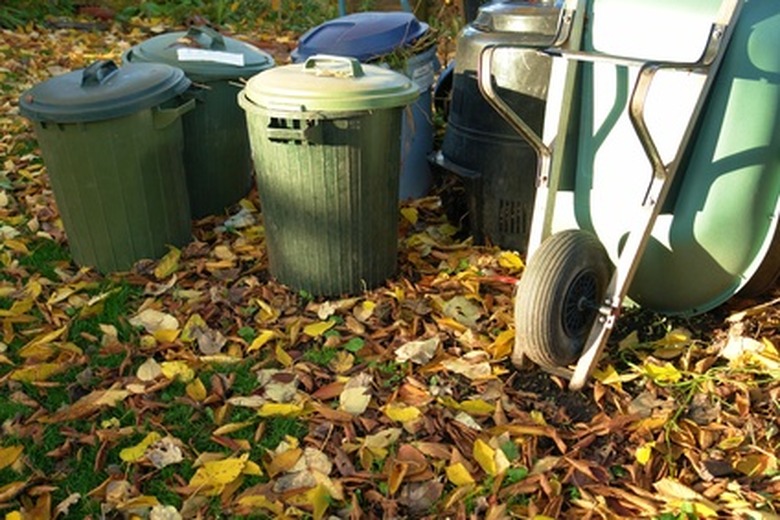How To Compost Walnut Leaves
Walnut trees are beneficial to a landscape for their nut harvest, moderate shade and foliage. The downside of growing a walnut tree is that not many companion plants do well nearby because of the juglone toxin produced by the walnut tree. In the past there has been some debate as to whether you can compost the walnut leaves or not, but it has been proven that you can compost the leaves with other items in a compost pile.
Step 1
Layer the walnut leaves into the compost pile. Begin with a layer of walnut leaves, then a layer of grass clippings and then a third layer of organic materials such as eggshells or fruit and vegetable matter. The pile needs to be at least 6 inches deep. Alternate with these layers while building the compost pile.
- Walnut trees are beneficial to a landscape for their nut harvest, moderate shade and foliage.
- In the past there has been some debate as to whether you can compost the walnut leaves or not, but it has been proven that you can compost the leaves with other items in a compost pile.
Step 2
Turn the compost pile each week to provide adequate air circulation and moisture. Use a shovel to sift materials from the bottom up to the top. Mix it thoroughly.
Step 3
Keep the compost pile moist. To see if there is enough moisture, pick up a handful and squeeze it. If no moisture seeps out, it needs more. Sprinkle with water, and turn with the shovel again.
- Turn the compost pile each week to provide adequate air circulation and moisture.
Step 4
Add more grass clippings if the compost pile begins to smell badly. You want the compost pile to smell of earth more than anything else.
Step 5
Let the walnut leaf degrade in the compost (while being turned with the shovel weekly) for at least a month. It takes four to six weeks for the juglone toxin to break down in the walnut leaves. When it is ready to use, compost should feel crumbly and have an earthy smell.
Compost
Adding compost is one of the best ways to boost a garden's ability to thrive without the use harmful chemicals. Carbon-rich, or "brown" matter, includes items such as tree bark, leaves, twigs and paper. Microorganisms such as bacteria, already present in the decaying matter, work together to break the pile down. A well-balanced compost pile produces usable compost in several weeks to several months, depending upon the size of the heap. Straw, shredded paper and chunks of plain corrugated cardboard are also excellent brown-matter add-ins for your compost pile or bin. * While fallen, dead branches count as brown matter, fresh garden clippings, such as pieces from pruned shrubs, are green matter. The paper filter counts as brown matter, completely welcome in the pile. A compost pile that heats up as it should will kill any weed seeds present. Breads, pasta, dairy and meat products, bones, animal waste, and kitchen grease or oils should not be added to a compost bin. Also avoid putting any materials treated with potentially harmful chemicals into the compost pile, as these may either kill the microbes that help break matter down or they may introduce harmful chemicals to the compost and to the areas where compost is spread. Try these sparingly at first to ensure they break down in a reasonable amount of time. Get started by selecting a shaded area that's easily accessible, since you'll add materials and water to it from time time. Always cover the green matter with 5 inches or more of brown to help keep insects and vermin away. Sprinkle the pile with water if it feels too dry, or whenever you add dry brown matter. A tarp over the top of the pile isn't required, but it helps keep the moisture in. If you feel a compost pile or homemade bin is too messy or difficult to deal with, consider a pre-made composting bin such as the barrel-shaped style designed to either roll or turn on a spindle. Expect it to take several months before the compost in a pile three feet tall is ready. Compost is considered gold in the garden, and it has several uses: * Add fresh compost around garden plants in layers up to 3inches deep as a mulch.
- Add more grass clippings if the compost pile begins to smell badly.
- Let the walnut leaf degrade in the compost (while being turned with the shovel weekly) for at least a month.
- The paper filter counts as brown matter, completely welcome in the pile.
Things Needed
- Walnut leaves
- Grass clippings
- Kitchen scraps
- Compost
- Manure
- Shovel
References
- Aggie Horticulture: Compost
- Landscape America: Composting
- Gardens Alive: Black Walnuts
- University of Illinois Extention: The Composting Process
- Gardener's Supply Company: Jumpstart Your Compost
- Bonnie Plants: How to Create a Compost Pile
- Fine Gardening: Hot Composting Versus Cold Composting
- ABC News: Can You Compost Citrus and Onion?
